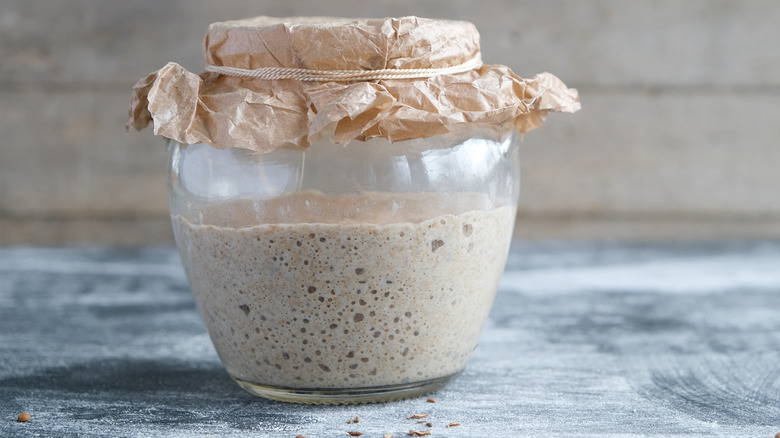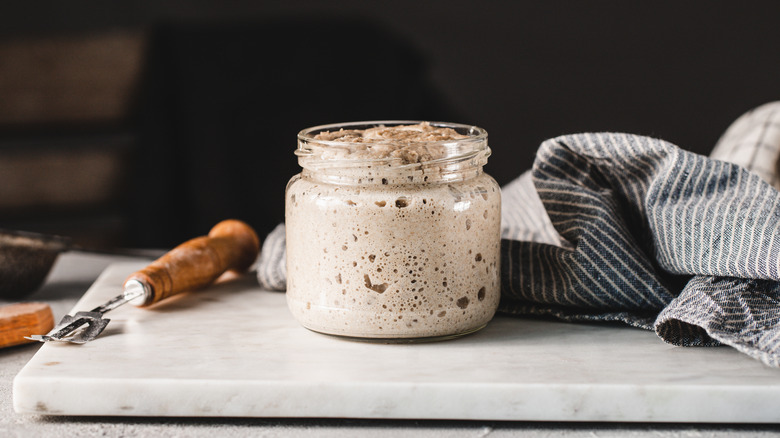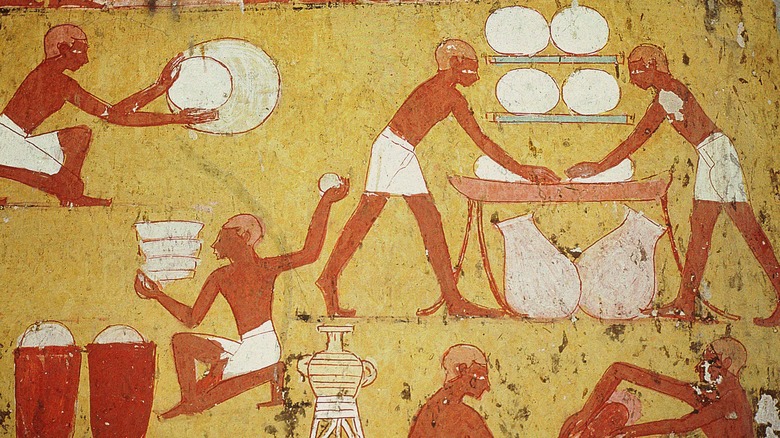The World's 'Oldest' Sourdough Starter Was Made With 4,500-Year-Old Yeast
There's no bread quite like sourdough. In addition to being tasty as a sandwich bread, delicious as sourdough croutons, and even great just toasted with butter, sourdough's production process is decidedly unlike other breads. The starters for sourdough, and the yeasts they're built from, possess unbelievable longevity. In 2019, that longevity was the key to the development of the "oldest" sourdough starter ever — or at least the oldest yeast ever used by a modern baker.
That year, tech entrepreneur and physicist Seamus Blackley (the co-creator of the original Xbox) decided to make and eat sourdough from yeast that was four and a half millennia old. It's important to note that Blackley didn't make bread using a literal 4500-year-old starter; no such continuous sourdough starters are known to exist. It was, however, made with yeast that in all likelihood long predates the founding of Rome, and in fact the yeast itself came from ancient artifacts that had once been used in brewing and bread-making. With the aid of Egyptologist Dr. Serena Love, Blackley secured access to Egyptian pottery from museums in Massachusetts, and with the help of microbiologist Richard Bowman, he was able to extract from them the yeast samples he'd need.
Blackley harvested yeast from ancient artifacts
To understand how this was even possible, it's important to understand the science behind a sourdough starter. While most bread comes from commercial yeast packets, sourdough is created from a wild yeast colony consisting of yeast, flour, sugar, and water. Within that colony, the yeast is allowed to do its work slowly, developing a unique flavor as it ferments, which is why every sourdough tastes different.
Unlike century eggs, which despite the name are typically made over a period of months, a sourdough starter can last well over an actual century as long as water and flour is added to it on a bi-weekly basis. In fact, if proper care is taken, it can last quite literally indefinitely, because yeast itself can theoretically last indefinitely.
This is because yeast that goes dormant is often not actually dead. In the absence of food, yeast can essentially go into suspended animation, germinating later when it has something to eat. This is exactly what Blackley did using his ancient yeast. It's not 100% clear specifically how old Blackley's yeast was, or how contaminated the samples were by environmental factors the pots had been exposed to over time, like dirt and oxygen. Modern growth media, meanwhile, were a no go, killing Blackley's first attempts at a starter — but historically accurate Emmer flour (a hybrid of Einkorn wheat and wild grass) worked to reactivate the yeast. That discovery eventually allowed Blackley to bake a sourdough loaf with it in August 2019.
Blackley ultimately baked the sourdough using ancient Egyptian techniques
In order to make a completely historically accurate sourdough, he needed not just a starter, but to translate ancient Egyptian baking methods. Using hieroglyphs and other contextual sources, Love cracked the code on how to make it happen. After nurturing the starter and practicing with dozens of loaves, Blackley built his own version of an ancient Egyptian "bedja," a clay pot used for baking. Then he dug a hole and baked it in the ground surrounded by embers — just like the ancient Egyptians once did.
As I mention in the thread above, the ancient Egyptians of that time period didn't use ovens like we do today. They baked in conical clay pots call "bedja." Here's one we made. I've been practicing for months, baking in a modern oven with bedja so I get can a feel for it. pic.twitter.com/6kAamQGKCi
— Seamus Blackley (@SeamusBlackley) March 30, 2020
The end result worked remarkably well. The wildest part is that in both instances — modern baking and using the bedja — the sourdough was apparently delicious, with Blackley declaring in his post that it tasted "much sweeter and more rich than the sourdough we are used to."
And here is the result. The scoring is the Hieroglyph representing the "T" sound (Gardiner X1) which is a loaf of bread. The aroma is AMAZING and NEW. It's much sweeter and more rich than the sourdough we are used to. It's a big difference. After this cools we will taste! pic.twitter.com/sYCJ8uP1oj
— Seamus Blackley (@SeamusBlackley) August 5, 2019
It took quite a lot of effort and the miracles of both modern science and historical study, but Blackley successfully made sourdough out of the oldest yeast any modern baker had ever used. Sadly, he never made any plans to produce and market it for the rest of us.


